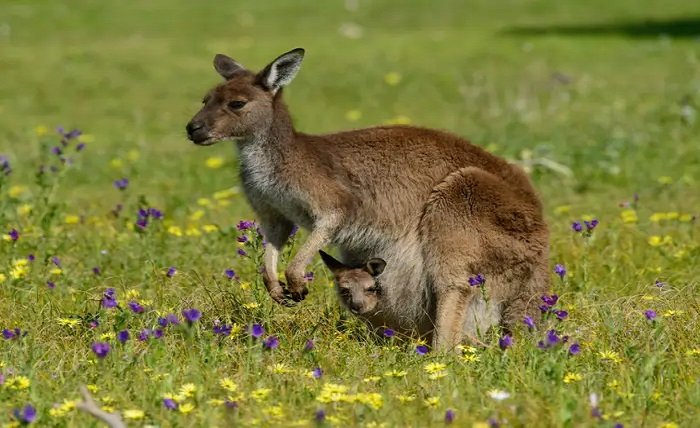Baby Kangaroos: Nature’s Remarkable Joeys

Baby kangaroos, commonly known as joeys, captivate people worldwide with their adorable features and unique developmental journey. From their gestation to their life in the mother’s pouch, joeys offer a fascinating glimpse into the reproductive strategies of one of Australia’s most iconic marsupials.
The Early Life of a Baby Kangaroo
The life of a baby kangaroo begins long before it first peeks out from its mother’s pouch. After a gestation period of just about a month, the newborn joey, blind and hairless, makes the incredible journey from the birth canal to the pouch. This critical period is when the baby kangaroo starts its life in a vulnerable state, relying completely on its mother’s pouch for protection and nutrition.
Development Within the Pouch
Once inside the pouch, the baby kangaroo continues its development for several months. The pouch environment is tailored to support the joey’s growth, equipped with nipples that provide nutrient-rich milk. Each stage of the joey’s growth corresponds to changes in the composition of this milk, ensuring that the baby kangaroo receives exactly what it needs at different growth phases.
Nutritional Needs of Joeys
As the baby kangaroo grows, its dietary needs evolve. Initially surviving solely on milk, the joey gradually begins to explore and nibble on grass and other available vegetation. This transition is crucial for the development of its digestive system, preparing the baby kangaroo for a life outside the pouch.
The Role of the Mother
The mother kangaroo plays a pivotal role in the survival and development of her joey. Besides providing milk, she also stimulates the joey to defecate and urinate by licking her young. This not only keeps the pouch clean but also reinforces the bond between the mother and the baby kangaroo.
Predators and Protection
In the wild, baby kangaroos face numerous threats from predators such as foxes, eagles, and dingoes. The mother kangaroo uses her keen senses to detect danger and will often leap away at high speeds to protect her vulnerable joey.
Learning to Hop
One of the most exciting developments for a baby kangaroo is learning to hop. Initially, joeys are clumsy, but with practice, they develop the powerful hind legs that kangaroos are famous for. This skill is essential for foraging and ultimately for survival in the rugged terrain of Australia.
Socialization Among Joeys
Baby kangaroos are not only raised by their mothers but also learn social skills within the mob. Young joeys play with siblings and other joeys, learning the dynamics of kangaroo society through these interactions. This socialization is crucial for their development into well-adjusted adult kangaroos.
Weaning Off the Pouch
The process of weaning is gradual for a baby kangaroo. Joeys start spending more time outside the pouch around 8 months but return regularly for milk. By 10 months, most joeys are fully weaned, marking a significant milestone in the life of a baby kangaroo.
Threats from Environmental Changes
Environmental factors, including climate change and habitat destruction, pose significant threats to baby kangaroos. Changes in the landscape and weather patterns can affect the availability of food and water, impacting joey survival rates.
Conservation Efforts
Conservation organizations work tirelessly to protect baby kangaroos and their habitats. Efforts include habitat restoration, legal protections, and rehabilitation programs for injured and orphaned joeys, ensuring that baby kangaroos have a fighting chance for survival.
The Cultural Significance of Baby Kangaroos
In Australian culture, the baby kangaroo holds a place of endearment and is a symbol of the country’s unique wildlife. This cultural significance helps garner support for conservation efforts and promotes awareness of the challenges facing baby kangaroos.
Conclusion
Baby kangaroos are more than just adorable creatures; they are integral to the ecological and cultural fabric of Australia. Understanding and supporting the conservation of these remarkable joeys is essential for ensuring that future generations can also marvel at these incredible marsupials.
FAQs
1. What is a baby kangaroo called? A baby kangaroo is called a joey.
2. How long does a baby kangaroo stay in the pouch? A joey typically stays in the pouch for about six to eight months before it starts to venture out more frequently.
3. What do baby kangaroos eat? Initially, baby kangaroos feed exclusively on their mother’s milk. As they grow, they gradually begin to eat grass and other vegetation.
4. How do mother kangaroos protect their young from predators? Mother kangaroos use their strong hind legs to kick, their speed to escape, and their keen senses to detect predators early.
5. Why are conservation efforts important for baby kangaroos? Conservation efforts are crucial due to threats from habitat destruction, climate change, and predators, ensuring the survival of baby kangaroos in the wild.





